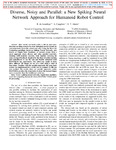Diverse, noisy and parallel: a New Spiking Neural Network approach for humanoid robot control
| dc.contributor.author | Azambuja, RD | |
| dc.contributor.author | Cangelosi, Angelo | |
| dc.contributor.author | Adams, SV | |
| dc.date.accessioned | 2018-01-10T03:00:03Z | |
| dc.date.available | 2018-01-10T03:00:03Z | |
| dc.date.issued | 2016-11-03 | |
| dc.identifier.isbn | 9781509006199 | |
| dc.identifier.issn | 2161-4393 | |
| dc.identifier.uri | http://hdl.handle.net/10026.1/10536 | |
| dc.description | keywords: Biological neural networks;Computational modeling;Liquids;Neurons;Noise measurement;Robots;Shape;BAXTER;V-REP;humanoid robots;liquid state machines;parallel;processing;reservoir computing;spiking neural networks | |
| dc.description.abstract |
How exactly our brain works is still an open question, but one thing seems to be clear: biological neural systems are computationally powerful, robust and noisy. Using the Reservoir Computing paradigm based on Spiking Neural Networks, also known as Liquid State Machines, we present results from a novel approach where diverse and noisy parallel reservoirs, totalling 3,000 modelled neurons, work together receiving the same averaged feedback. Inspired by the ideas of action learning and embodiment we use the safe and flexible industrial robot BAXTER in our experiments. The robot was taught to draw three different 2D shapes on top of a desk using a total of four joints. Together with the parallel approach, the same basic system was implemented in a serial way to compare it with our new method. The results show our parallel approach enables BAXTER to produce the trajectories to draw the learned shapes more accurately than the traditional serial one. | |
| dc.format.extent | 1134-1142 | |
| dc.language.iso | en | |
| dc.publisher | IEEE | |
| dc.subject | Biological neural networks | |
| dc.subject | Computational modeling | |
| dc.subject | Liquids | |
| dc.subject | Neurons | |
| dc.subject | Noise measurement | |
| dc.subject | Robots | |
| dc.subject | Shape | |
| dc.subject | BAXTER | |
| dc.subject | V-REP | |
| dc.subject | humanoid robots | |
| dc.subject | liquid state machines | |
| dc.subject | parallel | |
| dc.subject | processing | |
| dc.subject | reservoir computing | |
| dc.subject | spiking neural networks | |
| dc.title | Diverse, noisy and parallel: a New Spiking Neural Network approach for humanoid robot control | |
| dc.type | conference | |
| dc.type | inproceedings | |
| plymouth.author-url | https://www.webofscience.com/api/gateway?GWVersion=2&SrcApp=PARTNER_APP&SrcAuth=LinksAMR&KeyUT=WOS:000399925501042&DestLinkType=FullRecord&DestApp=ALL_WOS&UsrCustomerID=11bb513d99f797142bcfeffcc58ea008 | |
| plymouth.date-start | 2016-07-24 | |
| plymouth.date-finish | 2016-07-29 | |
| plymouth.volume | 2016-October | |
| plymouth.conference-name | 2016 International Joint Conference on Neural Networks (IJCNN) | |
| plymouth.publication-status | Published | |
| plymouth.journal | 2016 International Joint Conference on Neural Networks (IJCNN) | |
| dc.identifier.doi | 10.1109/IJCNN.2016.7727325 | |
| plymouth.organisational-group | /Plymouth | |
| plymouth.organisational-group | /Plymouth/Faculty of Science and Engineering | |
| plymouth.organisational-group | /Plymouth/Research Groups | |
| plymouth.organisational-group | /Plymouth/Research Groups/Institute of Health and Community | |
| plymouth.organisational-group | /Plymouth/Research Groups/Marine Institute | |
| dc.publisher.place | Vancouver, BC, Canada | |
| dcterms.dateAccepted | 2016-07-24 | |
| dc.rights.embargoperiod | Not known | |
| rioxxterms.funder | EPSRC | |
| rioxxterms.identifier.project | BABEL | |
| rioxxterms.versionofrecord | 10.1109/IJCNN.2016.7727325 | |
| rioxxterms.licenseref.uri | http://www.rioxx.net/licenses/all-rights-reserved | |
| rioxxterms.licenseref.startdate | 2016-11-03 | |
| rioxxterms.type | Conference Paper/Proceeding/Abstract | |
| plymouth.funder | BABEL::EPSRC |


